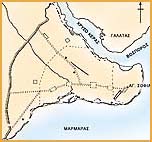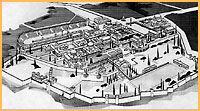|
The
imperiial buildings and monuments
 Statues and monuments, celebrating the imperial public image,
adorned the
fora.
A porphyry
column supporting the statue of Apollo-Helios provided
the focal point for the Forum Constantini . Another column
with spiral decoration, modeled after those of Trajan and
Marcus Aurelius in Rome, adorned the Forum Tauri, which was
laid out in the reign of
Theodosios I
(379-395). Close to it stood an
arch, supported on sets of
four columns each, their shafts decorated with drop-shaped
eyes' imitating the trunks of cypresses. The Philadelphion
was ornamented with two porphyry columns supporting carved
groups of Constantine's sons (such as the so-called Tetrarchs
now in the Piazza San Marco, Venice). Another spiral column
stood in the Forum Arcadii, its pedestal preserved to this
day. An equestrian statue of Justinian was set up on top of
a column in the Augustaion square, south of St Sophia .
Statues and monuments, celebrating the imperial public image,
adorned the
fora.
A porphyry
column supporting the statue of Apollo-Helios provided
the focal point for the Forum Constantini . Another column
with spiral decoration, modeled after those of Trajan and
Marcus Aurelius in Rome, adorned the Forum Tauri, which was
laid out in the reign of
Theodosios I
(379-395). Close to it stood an
arch, supported on sets of
four columns each, their shafts decorated with drop-shaped
eyes' imitating the trunks of cypresses. The Philadelphion
was ornamented with two porphyry columns supporting carved
groups of Constantine's sons (such as the so-called Tetrarchs
now in the Piazza San Marco, Venice). Another spiral column
stood in the Forum Arcadii, its pedestal preserved to this
day. An equestrian statue of Justinian was set up on top of
a column in the Augustaion square, south of St Sophia .
Amusement was essential to the life of the capital.
Chariot races and theatre plays were immensely popular. The
theatre was open from noon till evening, and staged  pantomime,
which involved dancing, music and some nudity, and, occasionally,
a play of more traditional (antique) type. Chariot races were
financed by
consuls and
organised by the capital's sports' associations, namely the
Blues, the Greens, the Whites and the Reds. They were staged
in the hippodrome, a vast structure consisting of tiers of
seats arranged in hairpin form. Here, the arena was divided
by a low wall (spina) supporting an assortment of statues
and obelisks; at the centre of the spina stood the obelisk
of Theodosios I, the marble base of which represented the
emperor and his court attending the games. The imperial box
(kathisma), in the middle of the southeast wing, was a two-storeyed
structure connected to the palace. Besides providing amusement,
the hippodrome was a focus for imperial ceremony and the place
par excellence where the emperor met his subjects. pantomime,
which involved dancing, music and some nudity, and, occasionally,
a play of more traditional (antique) type. Chariot races were
financed by
consuls and
organised by the capital's sports' associations, namely the
Blues, the Greens, the Whites and the Reds. They were staged
in the hippodrome, a vast structure consisting of tiers of
seats arranged in hairpin form. Here, the arena was divided
by a low wall (spina) supporting an assortment of statues
and obelisks; at the centre of the spina stood the obelisk
of Theodosios I, the marble base of which represented the
emperor and his court attending the games. The imperial box
(kathisma), in the middle of the southeast wing, was a two-storeyed
structure connected to the palace. Besides providing amusement,
the hippodrome was a focus for imperial ceremony and the place
par excellence where the emperor met his subjects.
The Great Palace, the imperial residence down to the
eleventh century, consisted of a number of halls, pavillions
and churches, connected by
galleries, and
separated by gardens. It featured a monumental vestibule,
the Chalke, opening on to the Mese, to the southeast of St
Sophia . The palace's residential wing,  the
Daphne, communicated with the imperial box in the hippodrome
. A magnificent sixth-century floor mosaic, the only surviving
example of secular mosaic decoration in Constantinople, adorns
one of the courtyards: fighting animals, bucolic and hunting
scenes, are set against a plain white ground, bordered by
foliage scrolls inhabited by birds animals and masks. The
palace possessed its own harbor and was protected by walls.
The private palaces of Hormisdas, Antiochus and Lausus lay
in proximity. the
Daphne, communicated with the imperial box in the hippodrome
. A magnificent sixth-century floor mosaic, the only surviving
example of secular mosaic decoration in Constantinople, adorns
one of the courtyards: fighting animals, bucolic and hunting
scenes, are set against a plain white ground, bordered by
foliage scrolls inhabited by birds animals and masks. The
palace possessed its own harbor and was protected by walls.
The private palaces of Hormisdas, Antiochus and Lausus lay
in proximity.
North of the Great Palace were the public baths of
Zeuxippus, lavishly decorated with statues. This, and many
other bathing establishments, were frequented by men, women,
children, and members of the clergy. The water supply was
guaranteed by a network of aqueducts and cisterns, such as
the enormous open-air cisterns of Aetius (421), Aspar (459),
and St Mocius (attributed to
Anastasios I,
491-518), or the covered Cisterna Basilica and Binbir Direk
cistern, both of which date from Justinian's reign.
|